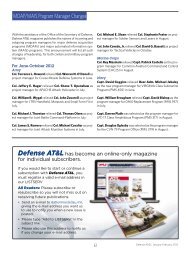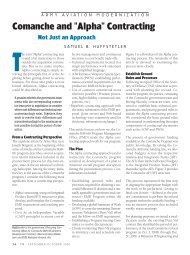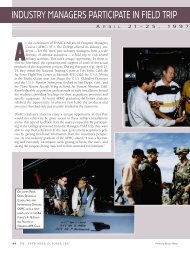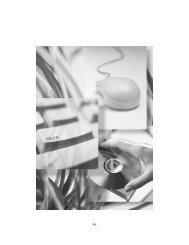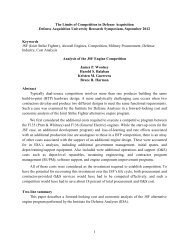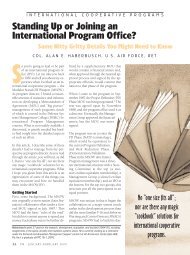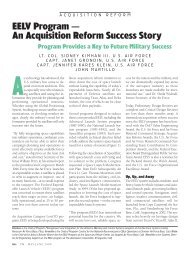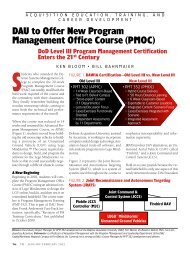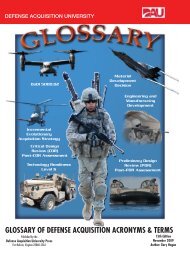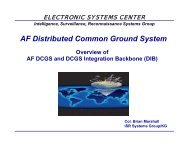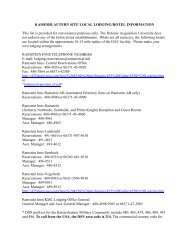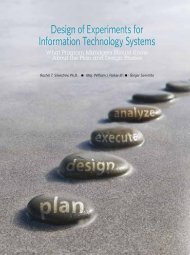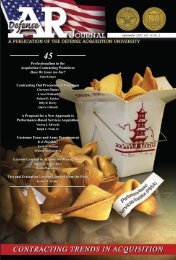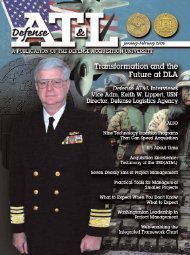Defense ARJ - Defense Acquisition University
Defense ARJ - Defense Acquisition University
Defense ARJ - Defense Acquisition University
Create successful ePaper yourself
Turn your PDF publications into a flip-book with our unique Google optimized e-Paper software.
<strong>Defense</strong> <strong>Acquisition</strong> Review Journal<br />
approximately 12 years. Sixty percent of the respondents were female. The online<br />
survey was activated in accordance with the tailored design method (Dillman, 2000).<br />
An initial e-mail was sent to ACA workforce members that included an Informed<br />
Consent Notification, the purpose of the study, the approval and sponsorship of the<br />
study, a confidentiality statement, and a link to the online survey. A subsequent follow-up<br />
e-mail summarized the first message, added a personal note, and provided a<br />
four-day extension along with a link to the online survey.<br />
Measures<br />
Self-leadership. Thirteen items from the Revised Self-leadership Questionnaire<br />
(RSLQ, Houghton & Neck, 2002) were used to measure self-leadership. The RSLQ<br />
has been used to measure self-leadership in numerous studies (e.g., Houghton & Jinkerson,<br />
2007; Houghton, Bonham, Neck & Singh, 2004; Neubert & Wu, 2006). The 13<br />
items demonstrated good reliability in the current sample with an alpha coefficient of<br />
.80—well above Nunnally’s (1978) recommended threshold of .70. The items were<br />
measured using a five-point Likert-type scale ranging from Completely Accurate to<br />
Not At All Accurate.<br />
Creative potential and practiced creativity. Eleven items were used to measure<br />
creativity, with six items assessing creative potential and five items representing<br />
practiced creativity (DiLiello & Houghton, 2008). DiLiello and Houghton (2008)<br />
assessed the construct and discriminant validity of the creative potential and practiced<br />
creativity concepts using an exploratory factor analysis (EFA) along with a<br />
confirmatory factor analysis (CFA) using structural equation modeling techniques.<br />
Their EFA demonstrated a clean factor structure for each construct with strong factor<br />
loadings and virtually no cross-loadings for any of the items, while the reliability of<br />
the items used to measure each construct was also quite good, with coefficient alphas<br />
of .84 for each of the two constructs (DiLiello & Houghton, 2008). CFA results also<br />
provided additional evidence in support of the construct and discriminant validity of<br />
these concepts (DiLiello & Houghton, 2008). Items were measured using a five-point<br />
Likert-type scale ranging from Strongly Agree to Strongly Disagree.<br />
Perceived organizational support for creativity. Perceived organizational support<br />
for creativity was measured with six items from “KEYS: Assessing the Climate for<br />
Creativity,” used with the permission of the Center for Creative Leadership (Amabile<br />
et al., 1999). The KEYS scale has shown good psychometric properties as evidenced<br />
by CFA results and by median reliability estimates of .84 across a number of studies<br />
(e.g., Mathisen & Einarsen, 2004). All items were measured using a five-point Likerttype<br />
scale ranging from Strongly Agree to Strongly Disagree.<br />
analyses<br />
Mean differences between supervisory and line employees for self-leadership,<br />
creative potential, practiced creativity, a gap score (i.e., the difference between<br />
creative potential and practiced creativity that represents untapped creative potential),<br />
and perceptions of organizational support for creativity were examined using a series<br />
of t-tests. In addition, a series of regression analyses were conducted to examine the<br />
102



